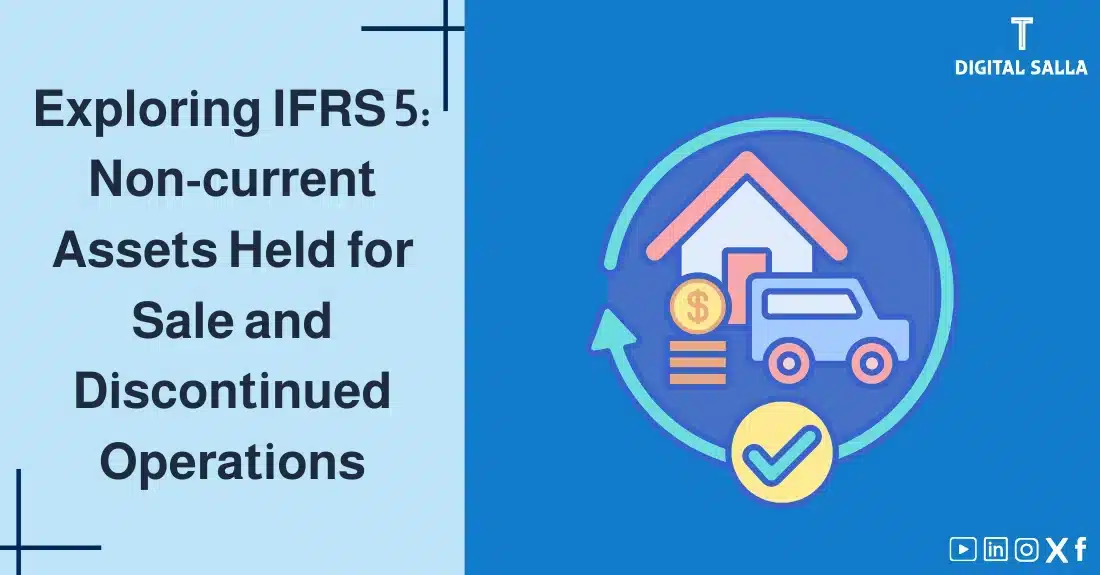Exploring IFRS 5 Standard: Non-current Assets Held for Sale and Discontinued Operations

IFRS 5 Standard, “Non-current Assets Held for Sale and Discontinued Operations,” provides specific accounting guidance for the presentation and measurement of non-current assets classified as “held for sale,” as well as for the presentation of the results of discontinued operations in the financial statements.
IFRS 5 Standard aims to distinguish assets that an entity intends to sell from those it intends to hold and use, and to provide more transparent information about the results of activities that the entity plans to discontinue. In this article, we will explore IFRS 5 Standard in detail, discuss its scope and key requirements, how to classify non-current assets as held for sale, and the recognition criteria for discontinued operations, highlighting the importance of this standard and its impact on the financial statements.
What is IFRS 5 Standard Non-current Assets Held for Sale and Discontinued Operations?
IFRS 5 Standard is an International Financial Reporting Standard (IFRS) that addresses how to present and measure non-current assets (or groups of assets and liabilities – disposal groups) that are classified as held for sale, and how to present the results of discontinued operations in the financial statements.
- Non-current Assets: Assets that are not expected to be converted into cash within one operating cycle or one year, such as property, plant and equipment, and intangible assets.
- Discontinued Operations: A component of an entity that has been disposed of or classified as held for sale, and represents a separate major line of business or geographical area of operations, is part of a single co-ordinated plan to dispose of a separate major line of business or geographical area of operations or is a subsidiary acquired exclusively with a view to resale.
Objectives of IFRS 5 Non-current Assets Held for Sale and Discontinued Operations:
- Improve the Presentation of Financial Information: IFRS 5 Standard aims to improve the presentation of financial information related to non-current assets held for sale and discontinued operations.
- Provide More Useful Information to Users of Financial Statements: IFRS 5 Standard helps users of financial statements understand the impact of the sale of non-current assets or the discontinuation of activities on the entity’s financial position and performance.
- Enhance Comparability: IFRS 5 Standard contributes to improving the comparability of financial statements of companies that apply IFRS.
- Clear Separation Between Continuing and Disposed Assets: IFRS 5 Standard helps to clearly distinguish between the results of continuing operations and discontinued operations, providing a clearer picture of the entity’s performance.
Scope of IFRS 5 Non-current Assets Held for Sale and Discontinued Operations:
IFRS 5 applies to all non-current assets (or disposal groups) that meet the criteria for classification as held for sale, and to all discontinued operations.
IFRS 5 Standard excludes from its scope:
- Financial assets that fall within the scope of IFRS 9 “Financial Instruments.”
- Deferred tax assets (IAS 12).
- Assets arising from employee benefits (IAS 19).
- Investment property measured at fair value (IAS 40).
- Biological assets related to agricultural activity measured at fair value (IAS 41).
Classification of Non-current Assets as Held for Sale:
An entity must classify a non-current asset (or disposal group) as held for sale if its carrying amount will be recovered principally through a sale transaction rather than through continuing use.
Criteria for Classifying a Non-current Asset as Held for Sale:
- The asset must be available for immediate sale in its present condition: The asset must be ready for sale in its current form without the need for substantial modifications.
- The sale must be highly probable: Management must be committed to a plan to sell the asset, and there must be a high probability that the sale will be completed.
- An active program to locate a buyer must be initiated: The entity must initiate an active program to find a buyer and complete the plan to sell.
- The asset must be actively marketed for sale at a reasonable price: The expected selling price must be reasonable and appropriate for the fair value of the asset.
- The sale is expected to be completed within one year from the date of classification: The sale should be expected to be completed within one year from the date the asset is classified as held for sale.
- It is unlikely that significant changes to the plan will be made or that the plan will be withdrawn: The plan to sell must be firm, and it is unlikely that it will be canceled or substantially modified.
Disposal Group: A group of assets that an entity intends to sell, together with any liabilities directly associated with those assets that will be transferred in the same transaction.
Measurement of Non-current Assets Held for Sale:
Non-current assets held for sale are measured at the lower of carrying amount and fair value less costs to sell.
- Carrying Amount: The value of the asset as it appears in the entity’s books after deducting any accumulated depreciation and any impairment losses.
- Fair Value: The price that would be received to sell an asset or paid to transfer a liability in an orderly transaction between market participants at the measurement date.
- Costs to Sell: The incremental costs directly attributable to the disposal of an asset, excluding finance costs and income tax expense.
Treatment of Impairment Loss:
If the fair value less costs to sell is lower than the carrying amount, an impairment loss must be recognized in the Income Statement.
Treatment of Value Increase:
If the fair value less costs to sell increases in subsequent periods, the increase can be recognized in the Income Statement, but not exceeding the cumulative impairment losses previously recognized.
Presentation of Non-current Assets Held for Sale in the Statement of Financial Position:
Non-current assets held for sale are presented separately from other assets on the Statement of Financial Position (Balance Sheet). Disposal groups are also presented separately, with the assets and liabilities composing the disposal group presented separately within the held-for-sale asset and liability classifications.
Discontinued Operations:
Definition of a Discontinued Operation:
A component of an entity that either has been disposed of, or is classified as held for sale, and:
- Represents a separate major line of business or geographical area of operations;
- Is part of a single co-ordinated plan to dispose of a separate major line of business or geographical area of operations; or
- Is a subsidiary acquired exclusively with a view to resale.
Presentation of the Results of Discontinued Operations:
The results of discontinued operations are presented separately in the Income Statement, and include:
- The post-tax profit or loss of discontinued operations.
- The post-tax gain or loss recognized on the measurement to fair value less costs to sell or on the disposal of the assets or disposal group(s) constituting the discontinued operation.
Disclosures Required for Discontinued Operations:
An entity must disclose sufficient information about discontinued operations, including:
- A description of the discontinued operation.
- An analysis of the revenue, expenses, and pre-tax profit or loss from ordinary activities attributable to the discontinued operation.
- The cash flows attributable to the discontinued operation.
Importance of IFRS 5 Standard for Users of Financial Statements:
IFRS 5 Standard provides valuable information to users of financial statements, such as investors and analysts, as it helps them:
- Evaluate the impact of the sale of non-current assets on the entity’s financial position.
- Understand the results of activities that the entity plans to discontinue.
- Analyze the entity’s financial performance more accurately by distinguishing between the results of continuing and discontinued operations.
- Assess management’s future plans regarding the sale of assets or the discontinuation of activities.
Challenges in Applying IFRS 5 Standard:
- Determining Whether an Asset is Available for Immediate Sale: It can be difficult to determine whether an asset is ready for sale in its current form without the need for substantial modifications.
- Estimating Fair Value Less Costs to Sell: It can be difficult to estimate the fair value of an asset, especially if there is no active market for it.
- Determining Whether a Discontinued Operation Represents a Separate Major Line of Business: This may require significant judgment.
Practical Example of Applying IFRS 5 Standard:
Scenario: Company “C” decided to sell its factory in City “X,” which is part of its manufacturing segment. The factory was classified as held for sale on December 31, 2023.
Steps According to IFRS 5 Standard:
- Classify the Factory as Held for Sale: Since Company “C” has decided to sell the factory, and the conditions for classification as held for sale are met, it should be classified as such on the Statement of Financial Position (Balance Sheet) on December 31, 2023.
- Measure the Factory at the Lower of Carrying Amount and Fair Value Less Costs to Sell: Company “C” must compare the factory’s carrying amount with its fair value less costs to sell and recognize any impairment losses.
- Present the Factory Separately on the Statement of Financial Position: The factory should be presented as a separate line item within current assets on the Statement of Financial Position (Balance Sheet).
- Present the Results of Operating the Factory as a Discontinued Operation: The results of operating the factory (revenue and expenses) should be presented separately in the Income Statement as a discontinued operation.
- Disclose Information Related to the Sale: Company “C” must disclose information related to the sale of the factory, such as a description of the factory, the reasons for the sale, the expected date of sale, and the fair value of the factory.
Impact of IFRS 5 Standard on Financial Statements:
- Statement of Financial Position (Balance Sheet): Non-current assets held for sale are presented separately, providing clearer information about the assets the entity plans to sell.
- Income Statement: The results of discontinued operations are presented separately, helping users of the financial statements to better evaluate the performance of continuing operations.
- Disclosures: IFRS 5 imposes specific disclosure requirements that provide additional information about non-current assets held for sale and discontinued operations.
Relationship with Other Standards:
IFRS 5 Standard is related to several other IFRS, such as:
- IAS 1 “Presentation of Financial Statements”: Specifies how to present non-current assets held for sale and discontinued operations in the financial statements.
- IAS 36 “Impairment of Assets”: Specifies how to test for impairment of non-current assets, including those classified as held for sale.
- IFRS 8 “Operating Segments”: May require additional disclosures about discontinued operations according to IFRS 8 if they represent a separate operating segment.
“For more comprehensive information on International Financial Reporting Standards, you can visit our article: [International Financial Reporting Standards].”
Conclusion:
IFRS 5 Standard provides a clear accounting framework for presenting and measuring non-current assets held for sale and discontinued operations. Applying this standard helps improve the quality and transparency of financial information and provides more useful data to users of financial statements. Understanding IFRS 5 Standard is essential for accountants, auditors, investors, and anyone seeking to understand how the sale of assets or the discontinuation of activities affects an entity’s financial position and performance. With the increasing number of restructurings and asset sales in the current business environment, the importance of IFRS 5 Standard as a tool for enhancing the transparency and reliability of financial reports is growing.
